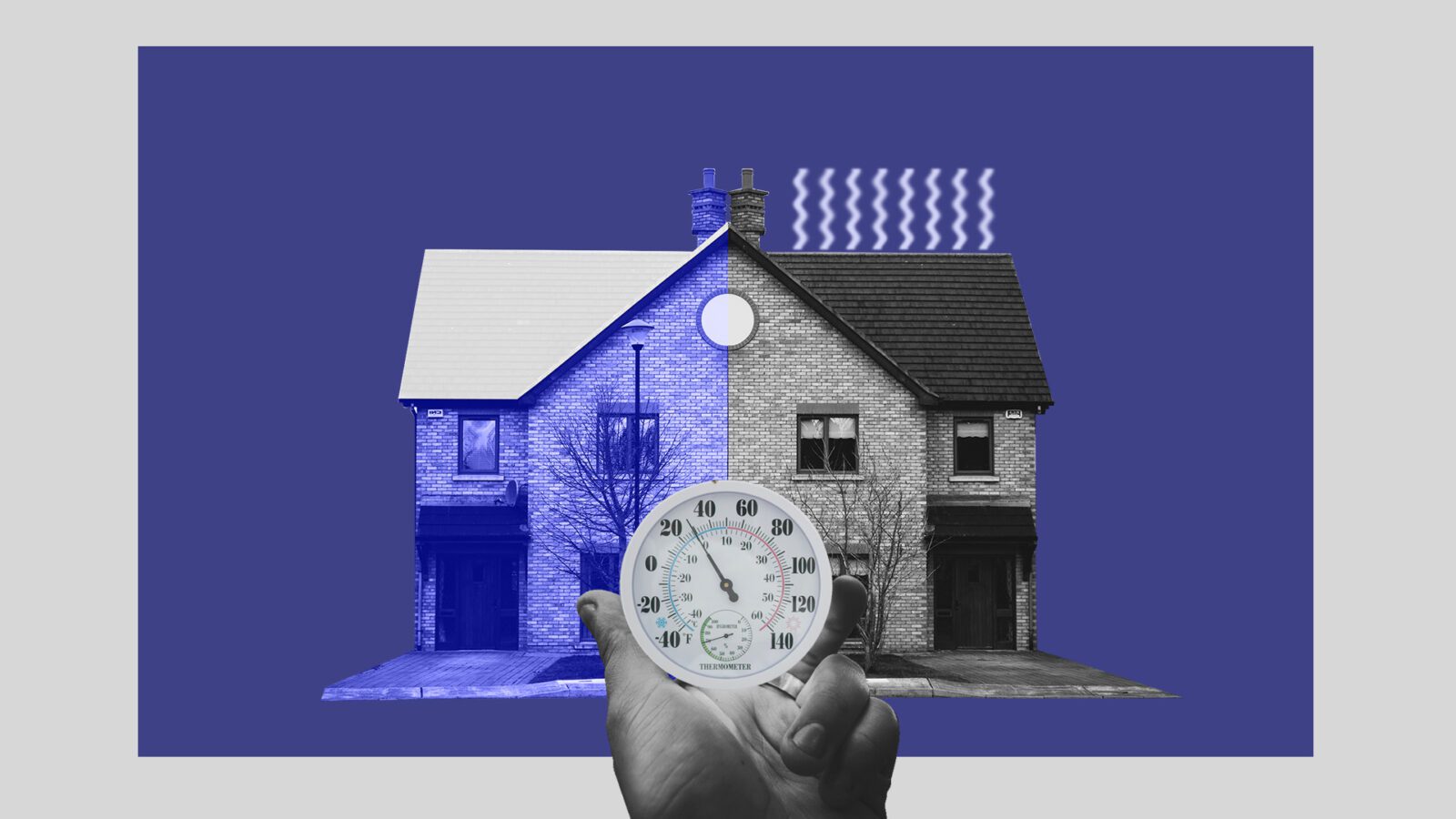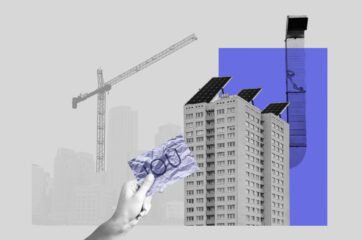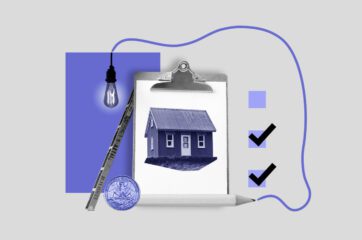Author
Destiny Gonzalez ǀ Policy & Research Program
This summer, cities endured soaring temperatures well beyond 100°F, making it likely the hottest summer on global record. Urban settings tend to trap more heat than less densely populated areas — straining economic resources, grid capacity, and public health for residents trying to keep cool. One way for cities to address this issue is through cool roofs, which reflect more sunlight, keeping indoor temperatures down.
Cool roofs increase building efficiency, cutting both energy costs and greenhouse gas emissions while protecting residents from dangerously hot temperatures. So far, the implementation of cool roofs has been limited, although they hold the potential to enhance the overall sustainability and resilience of our cities.
In this article, we explore the benefits and limitations of cool roofs and how states can utilize building codes, technical assistance, and environmental justice to promote their implementation.
Learn more about other Buildings & Efficiency policies on our Dashboard Resource Hub.
READ MORE >
What are Cool Roofs?
On a sunny summer afternoon in a major American city, dark roofs can reach temperatures of 150°F or more, contributing significantly to the urban heat island effect. They retain a substantial amount of solar radiation, acting as efficient heat absorbers. As a result, buildings with dark roofs experience increased energy demands and higher cooling expenses.
Cool roofs, on the other hand, are often lighter colors, which means their material can reflect a significant portion of solar radiation rather than absorb it, staying more than 50°F cooler. Reducing the need for cooling can result in cost savings for building owners and residents and emissions reductions from lowering overall energy needs.
Benefits of Cool Roofs
Climate Mitigation and Energy Savings
By reflecting up to 90 percent of absorbed heat compared to dark roofs, buildings with cool roofs need less energy to keep temperatures down. This can lower total building energy consumption by 14 to 26 percent, as well as reduce air-conditioning costs by 20 percent or more in hot, sunny weather. By enhancing occupant comfort and minimizing energy usage, especially during hot summers, cool roofs not only lower energy bills but also promote a more sustainable approach to building design.
Durability
Cool roofs’ lower surface temperatures can enhance the durability of roofing materials, reducing the need for frequent repairs and maintenance. Compared to dark roofs, they have a longer lifespan due to diminished deterioration from ultraviolet (UV) rays, resulting in the conservation of roofing materials and overall cost savings for building owners.
Public Health Improvements
Rising temperatures can exacerbate heat-related illnesses, including heat stroke and dehydration, particularly among vulnerable populations such as the elderly and those with pre-existing health conditions. Cool roofs have shown promise in creating healthier and more resilient communities by improving public health outcomes and preventing heat-related deaths, particularly for vulnerable individuals. For example, a 2012 Yale research study in New York City explored the health impacts of increasing roof albedo, (a measure of a roof’s reflectiveness on a scale of zero to one with one being the most reflective). This study found that increasing the roof albedo by a value of 0.62 in New York City would prevent 45 deaths during a heatwave.
Environmental Justice
Low-income urban communities frequently face a range of environmental challenges that exacerbate social and economic inequalities. Among these challenges is the urban heat island effect, a phenomenon where the high prevalence of heat-absorbing concrete and asphalt results in significantly higher temperatures in densely populated urban areas compared to their rural counterparts. Cool roofs offer a solution by reflecting more sunlight and absorbing less heat, thereby lowering urban temperatures. The implementation of cool roofs in these communities not only reduces health risks and energy costs but also addresses both environmental and socio-economic disparities.
Policy Barriers
Cost and economic considerations
To ensure cool roofs benefit low-income communities, policymakers and organizations should provide tailored funding and incentives to address affordability issues. However, it’s important to note that in programs like Louisville’s, which focuses on high-heat island areas, a significant number of low-income residents are renters. Convincing landlords to invest in building upgrades that ultimately lower tenants’ utility bills can be difficult, but states can address this challenge through efficiency standards, incentive programs, and education efforts.
Within the myriad of state policy avenues to create resilient and sustainable cities, cool roofs can present an effective path to healthier communities, lower energy bills, and greenhouse gas reductions, while aligning environmental justice objectives with state climate goals.
What States Can Do
Updating Building Codes
California’s building codes showcase how states can effectively promote cool roofs. The California Code of Regulations, updated in response to power shortages in 2001, integrates cool roofs into the state’s energy efficiency standards for residential and non-residential buildings. The standards are updated every three years, with the California Energy Commission collaborating closely with stakeholders.
In California, cool roofs must meet specific criteria, including a minimum solar reflectance of 70 percent and a minimum thermal emittance of 75 percent. Exceptions are made for concrete or clay tile roofs, allowing a minimum solar reflectance of 40 percent to accommodate cool-colored residential products.
These requirements apply to a wide range of construction projects across California, including new buildings, additions, alterations, and roof re-coverings in various building types such as nonresidential buildings, motels, hotels, relocatable public school buildings, multifamily buildings, and single-family residential buildings. The precise standards are tailored to factors like climate zone, building type, roof size, and slope, ensuring that energy efficiency measures are customized to suit the state’s diverse building and environmental conditions.
Learn more about how states can reduce emissions through building codes in our Dashboard Digest Article: Writing a Blueprint for Efficiency with Energy Codes
READ MORE >
Provide Technical Assistance
States can maximize the effectiveness of technical assistance when it comes to implementing cool roof policies, especially for states unable to commit substantial financial resources to installing cool roofs. Technical assistance programs can be utilized to incentivize cool roof adoption and drive behavioral change.
Washington’s HB 1114 (2021) sets up assistance for shade tree and cool roof programs to mitigate urban heat island effects. This legislation encourages municipal utilities and public utility districts to establish these programs, clearly defining their objectives and advantages.
To ensure fairness in implementation, the bill suggests using the Washington Department of Health’s environmental health disparities map, which aids in prioritizing communities with significant disparities for cool roof programs. The legislation also promotes collaboration with the state’s Department of Natural Resources Urban and Community Forestry Program (UCF), providing tailored technical assistance and capacity building for cool roof initiatives.
HB 1114’s primary goal is to actively involve and educate communities in cool roof decision-making. By capitalizing on existing resources and expertise, this approach makes implementation efficient and cost-effective, exemplifying how states can serve as advisors in cool roof strategies.
Prioritize Environmental Justice
States have the opportunity to prioritize Environmental Justice (EJ) when implementing cool roof policies through two key strategies: engaging stakeholders and providing financial assistance.
Engaging Stakeholders: The NYC CoolRoof Program, launched in 2009 as a partnership between city agencies and The HOPE Program, demonstrates effective stakeholder engagement. The program combats urban heat islands, enhances sustainability, and reduces energy consumption.
The program sets stringent cool roof requirements for significant roof renovations and actively encourages participation by building owners, managers, and contractors through rebates and technical support. Collaborative efforts with community organizations, nonprofits, and the private sector maximize outreach and impact. The program also closely monitors cool roof installations, using data to improve strategies and policies.
Providing Financial Assistance: Louisville’s Cool Roof Incentive Program offers financial incentives to combat urban heat islands, strategically targeting areas with the highest heat. Property owners are encouraged to adopt cool roofs with $1 per square foot incentives.
The program aims to incentivize at least 100,000 square feet of cool roofs in Louisville, with financial incentives limited to three properties per owner per fiscal year. Both residential and non-residential buildings are eligible, with varying incentives based on property type and roof slope. Stringent eligibility requirements ensure quality standards.
Transparency and accountability are promoted through the program’s cool roof incentive dashboard, allowing residents to track cool roof benefits in the city. This initiative aligns with broader goals of sustainability and equity through cool roof adoption.
Read More
- U.S. Environmental Protection Agency (2023) — Using Cool Roofs to Reduce Urban Heat Islands
- Department of Energy — Cool Roofs: Efficient Design
- Department of Energy — Cool Roof Savings Calculator
- Cool Roof Rating Council — What’s So Cool About Cool Roofs?
- U.S. Green Building Council — Online Cool Roof for Green Building Course, Part 1 and 2
- Global Cool Cities Alliance — Cool Roof Policies for Cool Cities







